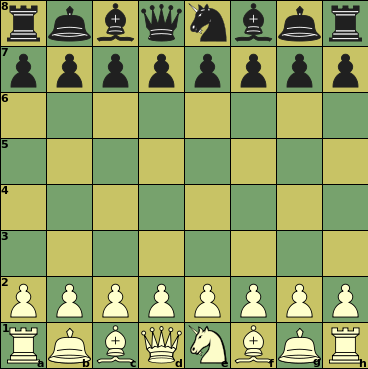Knightmate
 |
Initial setupe1, e8: Royal Knight |
Moves at a Glance
Click on a piece below to see its moves
 |
 |
 |
 |
Sliding capture or non-capture, can be blocked on any square along the ray |
|||||||
 |
Unblockable leap (capture or non-capture) | ||||||||||
 |
Non-capture only | ||||||||||
 |
Capture only | ||||||||||
 |
 |
 |
 |
 |
 |
 |
|||||
 |
|||||||||||
:
:
:
:
| Piece | ID | value | Moves (Betza notation) | Remarks |
| Royal Knight | K | - | N | Can castle with Rook, moving 2 steps towards it |
| Queen | Q | 10 | RB or Q | |
| Rook | R | 4.5 | R | |
| Bishop | B | 3.25 | B | Color-bound |
| Commoner | M | 3 | K | |
| Pawn | P | 1 | mfWcfF | Promotes to Q, R, B, or M on reaching last rank |
Pawn peculiarities
- Pawns capture differently from how they move (straight move, diagonal capture).
- Pawns can move two squares straight ahead from their initial position, provided they are not blocked.
- On the move immediately after such a double push, they can be captured en passant by another Pawn, as if they had only moved 1 square ahead.
- Pawns promote to another (non-royal) piece of choice when they reach last rank.
Castling
A Royal Knight that has not moved before can move two squares in the direction of a Rook that has not moved before, in which case that Rook is moved to the square on the other side next to the Royal Knight. This is only allowed if all squares traveled through by Royal Knight and Rook are empty (after their removal), when the Royal Knight is not in check on the square it came from, and would not be in check on any of the squares it skipped over.
General rules
- It is not allowed to expose your Royal Knight to check.
- The game is won by checkmating the opponent's Royal Knight.
- Stalemate (no legal moves, but not in check) is a draw.
Differences with FIDE
The King moves as a Knight, the Knights move as a King.
Strategy issues
It is not possible to force checkmate on a bare King with just a single Rook, Bishop or Commoner (in addition to your own King). All pairs of pieces can force checkmate on a bare King, however. A Queen can even do it without help of its Royal Knight, and is thus extremely dangerous.
Bishops are confined to squares of a single color. Having Bishops on both colors compensates this weakness, and is worth an extra 0.5 on top of their added value.